Featured Artist:
Janis Logsdon Jewelry and Art: From creepy campy to elegantly spooky one of a kind collectible handmade jewelry and accessories by Janis Logsdon also known as Jan’s Beads.

Featured Artist:
Janis Logsdon Jewelry and Art: From creepy campy to elegantly spooky one of a kind collectible handmade jewelry and accessories by Janis Logsdon also known as Jan’s Beads.

Trick Or Treat!
The 2014 Trick or Treat Give Away has concluded! The winner will be contacted via email. Thank you to all the folks who Trick or Treated! Visit Halloween Artist Bazaar to find more holiday events and give aways through out the year. We appreciate your interest in Halloween Artist Bazaar and for keeping the spirit of Halloween alive!
Keep your Jack o’ lanterns lit in solidarity, and to all a
HAPPY HALLOWEEN!
*************************************************************************************************
How To Enter:
Visit one of the contributing HAB artist shops and leave them the message “Trick or Treat” in the subject line.
Next like the HAB Facebook page and message us “Trick or Treat” on our wall.
Fill out the form below.
Official Rules
Entry deadline is Midnight on October 20th 2014. The Winner will be chosen at random. One entry per person. Winner will be notified via email. The prize will ship on October 21st 2014. The winners name will be posted on the Halloween Artist Bazaar website and Facebook page. Members of Halloween Artist Bazaar are not qualified for entry.No age restrictions. Contest open internationally, however please note that prize may not arrive before October 31st due to international shipping delays.*your countries custom charges may apply.*
Contributing Halloween Artist Bazaar Artists:(check back as the list grows and photo’s of the winnings are posted!)
Twilight Faerie
Art By Sarada
Ghost Gap
Gothbunny
Jan’s Beads
Jynxx Designs
Odd Origins
Tocsin Deigns
twistedpixelstudio
Wicked Alterations
Sauvage Raven Creations
Lttle Shop of Horrors
Featured Artist:
Sauvage Raven Creations: Macabre and creepy handcrafted skeleton creations and other creepy things from the dark reaches of the creative imagination of Sauvage Raven Creations.
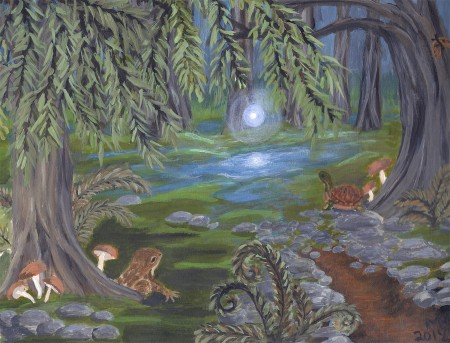
The Will o’ The Wisp
-By Angelique Duncan
Will o’ the wisp quite literally meaning the will of the wisp. A thing that is completely hopeless yet perused despite the difficulty and even impossibility of ever finding or catching it. Wisp being a torch made from burning straw.
On nearly every continent a phenomenon exists that has never completely been explained: glowing lights that appear and hover over the ground. Most commonly they have been sighted in marshy places such as swamps, ponds and rivers although there are some regions where they have been seen in the thick of forest, in prairies and desert mountain ranges. Sometimes they are seen in cemeteries. Usually no bigger than a fist, although there have been reports of small lights the size of candle flames and others the size of a melon. The colors vary as well. Typically they are described as white with bluish or greenish tint, although yellows, oranges, violet and red lights have been seen. Despite the variations in the lights that have been described there are two universal consistencies to the phenomenon. First, these lights cannot be captured and when observed they seem to interact with the viewer by following or “leading them”. The second is that they are not completely explained by science.
Early theories explaining the lights are that they are formed from methane gas escaping from the earth and spontaneously combusting as it is released. A more sophisticated theory is that the lights form from a combination of phosphine, diphosphane and methane produced from decomposed organic matter and create phosphoric acid when in contact with water vapor and ignite by photons released when in contact with oxygen. These theories could account for glowing spheres seen in marshes and swampy areas.
Other theories are that the lights are an electrical phenomenon of random ball lightening formed from naturally occurring electricity in the air. One belief is that as fault lines move piezoelectric materials such as arsenic or quartz are heated and escape through water vapor causing an electrical reaction, a possible explanation for the lights seen over desserts and prairies if those elements are present.
The lights have been attributed to being the result of bioluminescence in which luciferin is released and reacts with oxygen to emit a greenish or bluish light. Bioluminescence occurs in fireflies and glowworms and a handful of other creatures and insects. Some fungus and algae’s produce this glowing affect attributing the occurrence of glowing spheres to spores being released in clusters causing the glow affect.
Perhaps to a certain degree one could say that any one of these scientific theories would be a sound explanation for the sightings of hovering glowing orbs over landscapes. Except that in some regions and continents where the will o’ wisp have been seen the aforementioned conditions aren’t present to create them. Another inconsistency is that the descriptions of the lights that have been reported are not exclusively consistent with the light effect that would be produced by the environments and reactions stated by the theories. Witnesses have claimed to see light emitting orbs that are bright enough to illuminate their surroundings and others claim to see faint translucent flickers with their light contained.
Other explanations exist explaining the will o’ the wisp. Their reason for being may be found in folklore and legend. It is widely believed across European counties that the wisps are faeries or magical elemental beings. Depending on the region the mysterious lights are interpreted through folklore as mischievous faeries that use their “fairy fire” to trick travelers into following them, only to leave them stranded in a bog or marsh far from the path the traveler was on. It is said the lights resemble torches or lanterns from a distance causing a lost traveler to be drawn to them in hopes of finding their direction back to their village. One of the most widely held beliefs is that they are faeries who either are mischievously attempting to trick travelers into following them, either to lead them to the faerie realm or merely to guide them from their path and cause confusion.
Others say the lights are not faeries, but wicked goblins of the Pooka or Puca variety whose intent is malicious and wish to kidnap or cause harm to humans by tricking a wandering traveler into following them to swampy places from where the person is never seen or heard from again.
Different versions of this mythology exist in Mexico, South America and Asia. The stories are nearly identical to the European tales yet the explanation as to what the lights actually are differs. In Mexico and South America, the lights are associated as witches casting spells, luring humans to follow them for sinister intent involving witchcraft.
In Asia the lights are believed to be the wandering spirits of the dead. Ghosts who have not passed into heaven, destined to stay on earth. The deviation of the story, being that the lights will appear over open waters to lead fishermen astray from shore. Some believing them to be the ghosts of dead fishermen or people who have drowned and whom wish to bring more souls underwater to live with them.
These stories of “ghost lights” corresponds with Norse and Scandinavian mythologies that the wisp are believed to be guardians of ancient graves, protecting them from desecration by leading people away from the burial spot. In many cultures spheres have been sighted in graveyards and cemeteries.
Some say they are the spirits of the dead looking for companionship by leading souls to their graves where the lights trick them into the misfortune of staying. A similar folklore states that the lights are a warning of a pending death and that a funeral will be held soon. Some traditions tell that the lights will appear close to buried treasure and if one is brave enough to follow the light and survive they will be rewarded with the riches. No one to date has returned from following the floating lights bearing treasure.
In Europe another common theory is that the floating lights are the souls of unbaptized children forced to stay on earth until they receive baptism. The legend goes that a man of faith came across three unbaptized travelers who asked to be baptized and when the man went to baptize them the souls of all the un-saved children of the earth appeared with hopes to pass into heaven. The man spent the entire night baptizing souls until the sun rose. Those who he did not baptize that night are said to be the lights of unbaptized children who wander the earth.
A variation to the myth is that the lights are the souls of scoundrels not allowed into heaven and rejected by hell. Many cultures associate the will of the wisp with the origins of Jack o’ lanterns, that the lights are souls who are trapped in a cold dark hell on earth and have been given only a lump of coal to light their way and keep warm.
Not all mythologies surrounding the wisps are foreboding. Some stories tell that the lights are benevolent in nature. Pixie lights are pixies who live in the deep of woods who if treated kindly and with respect will help lead a lost traveler who has gone astray back to the path home. Hence the meaning the will of the wisp in that only the barrier of the wisp torch will decide one’s fate.
Sightings of explained lights that hover over water and land have been documented through out history and sightings continue to modern day. As to what or who they are there is no solid single explanation. Perhaps they are the elegant result of chemicals and electrical phenomenon. Maybe they are something ancient and enchanting. There isn’t a definitive answer, thus the will o’ the wisp remains a mystery, and that in and of itself is something magical.
Image “Will Of the Wisp” Copyright Michelle Angelique Duncan
Angelique Duncan is proprietor of Twilight Faerie Nostalgic and Capricious Objects. Check out her artist page to find links to her shops and vintage inspired traditional holiday art. Visit again next month for more traditions and folklore.
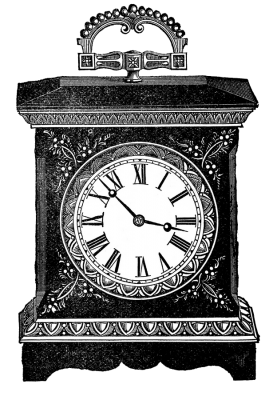
What Time Is It?
-By Debbi Decker
My mother passed recently and I had been spending time at her house, cleaning and gathering things to send to Goodwill and other charitable organizations. Towards the end of a 6-day stay, I was still trying to understand why the house felt so “clear”. It was not an after effect felt by me due to my mother’s death. I had noticed from the moment I walked in that the house felt empty. As if no one had ever lived there. I was confused, curious, and a bit unnerved. Houses imprint. Unless the place is brand spanking new, there are going to be elements that will resonate with everyone. I even commented to several family members and friends about the emptiness that I felt. My brother commented that he could feel it too but he felt that it would change.
The last full day I was there, I spent the day alone cleaning and sorting until late afternoon. I stepped out to get a bite to eat and to wind down from my busy day. After finishing my meal and checking the day’s e-mails, I decided to kick back in a very comfortable recliner in the living room and read until it was time to head to bed. Within a few minutes of reading, I began feeling a sense of heaviness in the atmosphere. As the evening wore on, and the sense of heaviness increased, I several times stop reading, looked around and tried to figure out exactly what I was feeling. The house was now occupied by someone or something other than me. I was not able to figure out who or what it was, but as the feeling got stronger I began to sense that it did not quite like me being in the house. It was not a hateful or hurtful feeling, but more of a “why are you here and you need to leave” kind of feeling.
At that point, I figured I would head to my room, read some more and then try to get some sleep. I noticed the digital clock at my bedside nightstand was not working. Thinking it was a battery issue, I went into my mother’s bedroom and rustled up some batteries and inserted them into the clock. The clock would light up, and then within 2 seconds the numbers would appear to melt from the top to the bottom and the clock would stop working. I fiddled with the clock trying to fix it for several minutes and it continued to react in the same manner. Assuming that the clock was broken, I went back into my mother’s bedroom to get a clock that was on her dresser. This clock, although battery operated, was not digital, had hour, minute, and second hands, and was running but the time was wrong. I reset the time and the clock stopped working. Again, I inserted fresh batteries, but nothing changed. That clock would not run either.
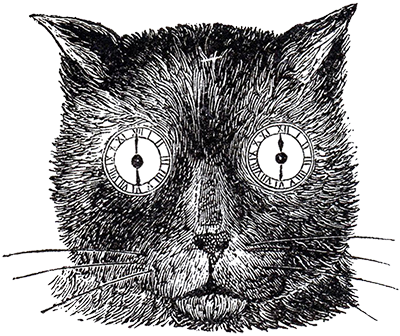
Now, I was two clocks down, with a house that was feeling creepier and heavier by the minute. I was frustrated and starting to get a bit edgy. Both clocks were put on my mother’s dresser in her room. I had to have a clock that worked though. It was important to me that night that I be able to see the time at any moment. Eventually, I found a small clock that was working, placed it on the nightstand beside my bed, and proceeded to read until my eyes were blurry. I was unable to get any sleep that night. It was a doze off, wake up, and repeat kind of night. I never did turn off the lights. And I was NOT leaving that room. For whatever reason, my room felt the least strange of all of the rooms in the house that night.
Morning came, and I managed a sleep-deprived stagger into the kitchen to make some coffee and get ready for the day. My sister was due early to assist with the sorting of mom’s clothes and further cleaning out of closets. Although the house felt a bit better than it had the night before, there was still a sense of occupancy and some heaviness.
My sister arrived and we began our day. Going back into mom’s bedroom to retrieve some items we needed, I happened to glance at my mother’s dresser. Both clocks were up and running perfectly, with the right time displayed on both! The heaviness I’d sensed the night before seemed now to be centralized in my mother’s bedroom. I quietly walked out and shut the door behind me.
I’m sure you can imagine all the swear words I was speaking under my breath. I let whatever or whoever it was that messed with those clocks the night before know that I was not amused. And I left a day earlier than originally planned and drove home.
Debbi Decker is proprietor of twistedpixelstudio Art & Assemblage Emporium. Check out her artist page to find links to her shop and blog to read more of her writings. Visit again next month for the telling of hauntings and ghostly tales by Debbi Decker.
Featured Artist:
One Paintin Lady: Unique sculpture in paper clay and mixed media of macabre yet charming creatures and monsters with soul from the hands and mind of Marcia Kert, One Paintin Lady.
A Tale of Winter
By Intricate Knot
“Just as Spring needs the Faeries,
Winter must have her Wizard.
For who but a Wizard could make all those varied and wondrous snowflakes?
Keep up.”
~ Intricate Knot
Prologue
When last we left our heroes and esteemed members of the Great Holiday Making Tribe, Fiddler and Wilbur (after a bit of schooling by Fizzy) had made up with Glassy. In turn, Glassy led them to the Faeries, Aloysius, Artemis, bunny helpers and fall assistants, flowers and pumpkins! Everyone was (and still are) back where they belonged, everyone of course except the villainous Diavix Clop, who sadly is still hiding somewhere in the Forest. Not where he belongs at all…

Winter had come in its full Magickal and icy force. Yule also came and a merry time was had by all. But from there things went a bit doolally…
The New Year should have begun, but somehow didn’t. Storms of rain and snow should right now be drumming and thrumming, sprinkling and crinkling throughout the Forest. But that’s not what’s happening!
For as suddenly as winter had come, it left. More baffling, it had left without a seasonal bridge between it and summer. Begging the Shakespearean question,
“What fresh madness is this?”
Fiddler, our fine, sleek, musically inclined feline and Wilbur, our coal feathered, grumpy, Magickally disposed owly-raven pondered this and many other questions. For they now had not only one but two mysteries to solve in the Forest. How is it possible that winter left so quickly? Without a sign, hide, nor hair? Usually the snow began to melt, exposing the earth, dark brown and fertile. In turn the slumbering earth awoke letting her hair down…or up (so to speak) by sending out tiny green shoots sprouting upwards to reach for the sun. Bare limbed trees yawned and stretched, their branches tingling with fresh leaves. Leaves steadily growing by the hundreds and all to be gloriously full blown just in time to bring much needed shade for the coming heat of summer.
Not so this year! One day there was snow on the ground with temperatures well below zero. The next day the ground was covered in tall, golden grass…summer grass. And not the summer of June, but the full-heated-swing, the tip most peak of summer: August. What of spring? And where did all the lovely fruit go? What’s summer without peaches and cherries? Apples and blueberries? A day feels far too long and hot in the summer without fruit pies to share with your friends!
Our heroes pondered while Fiddler dangled his smart red fishing pole and Wilbur dipped his very fine claws at one of their very favorite thinking spots, Thoughtful Pond. Every Forest should have one. If yours doesn’t, please go out and get one immediately.
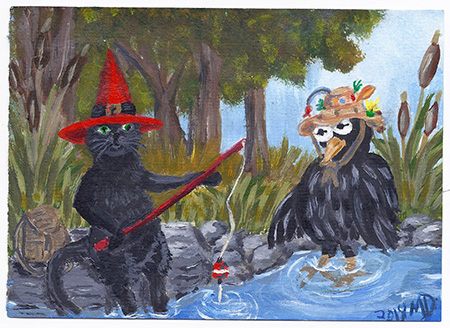
“It can’t be a coincidence,” Wilbur said firmly.
“Indeed, it cannot,” Fiddler agreed. “But how is it possible that Diavex has hidden from us for this long?”
“However and wherever he is, one thing is becoming clear.”
“Which is?”
“Diavex doesn’t like the cold.”
“Hmm…” Fiddler pondered. “Well that is something we can use to our advantage. Come on Wilbur, we have someone to see.” In the way of cats, Fiddler had leapt from his sitting position and was already halfway down the path before Wilbur had time to pull his claws from the pond. That was fine with Wilbur, though. Being such firm friends, he was quite accustomed to it.
Puffing a bit when he’d caught up with Fiddler,
“Who-who are we-e going to see?”
“The Winter Wizard, I think we need a bit more snow in our Forest, don’t you?”
“Absolutely! Good old Crimson, why we’ve not seen him in-”
“Years.”
“Since-”
“Yep. Since-”
Wilbur slowed his pace and fell silent. When Wilbur went silent it was palpable.
“What?” Fiddler shrugged. “Crimson has no reason to be upset with us.”
Wilbur merely grunted and then stopped in his tracks. Fiddler had breezed past five wise oaks before he realized that his pal was no longer beside him. Silkily, he turned and meandered his way back,
“Okay. You’re possibly right.”
At Wilbur’s look, Fiddler gave a great sigh,
“Yes, yes. It is possible, perhaps even probably that Crimson could be a tiny bit annoyed with us, but that’s not really the same as being upset.” Now, Fiddler didn’t exactly huff. Huffing isn’t something cats do, per se. Cats are very good at oozing frustration though, and Fiddler oozed with the best of them.
“Again with the ‘look,’ Wilbur? Please speak your mind.”
They knew one another well, these two. Right now Wilbur knew that Fiddler bordered on annoyed, which is very Un-Fiddler-Like. He knew he needed to tread lightly. Crimson was one of Fiddler’s most favorite of souls.
“I see three possibilities right now,” he began softly. “One, Diavex has somehow coerced Crimson into helping him. Two, Crimson is in league with Diavex Clop. Or three, something happened to the Forest’s Winter Wizard suddenly. So suddenly that there’s not been time to replace him.”
Fiddler sat back on his haunches.
“Any of which explains the lack of segue in our seasons.” It was Fiddler’s turn to fall silent.
Being a true friend through and through, Wilbur knew when to talk, when to jab, and when to be still. Stillness was called for here. So, he just sat right down next Fiddler to wait for him.
Wizards are of course revered in the Forest, and there are so very few left. If one were to fall, well, it is quite possible that there wouldn’t be a replacement. But to replace Crimson? Fiddler couldn’t conceive of it. Yes, Crimson was particularly special to Fiddler.
Everyone should already know this, but in case you’ve forgotten, every cat (and every owly-raven for that matter) must have a Magickal Mentor. Crimson had been Fiddler’s. And like a revered parent, one’s mentor will always claim a special place in one’s heart.
Crimson being gone, was not an option. Could he be in league with Diavex? From what Fiddler could recall…well hmm…actually, that wasn’t a lot to recall. Crimson had not been forthcoming on his relationship with the insidious Mr. Clop, but yes, Fiddler sensed there had been something there…a previous encounter. Though he knew nothing solid, he knew this, Crimson would not knowingly, willingly, or otherwise purposefully aid Diavex Clop. It would be against the Forest and Wizard code.
And with that Fiddler stood and nodded firmly,
“I am not prepared to believe that Crimson is gone from the Forest by design or cause. You could be right and it may be that he has been coerced into helping Diavex. But a fourth possibility occurs to me, perhaps he was taken by surprise and Diavex somehow imprisoned him.”
Wilbur stood up and dusted off his feathers,
“Either way then, he needs our help. Let’s go.”
To be continued next season!!
Illustration “Thoughtful Pond” by Angelique Duncan. Appearance of Wilbur with permission of Intricate Knot.
Illustration “Flourish” by Intricate Knot.
Intricate Knot is proprietor of Art For A Gloomy Day.Check out her artist page to find links to her shop and blog to read more of her writings. Visit again next season for more adventures of Fiddler the cat and his best pal Wilbur.

HAB Presents
Deep in the thick of the forest are haunted places, dusty forgotten cemeteries, abandoned mills, spooky coal mines and shaded ravines where monsters, goblins and spirits dwell. These places are the Dark Hollows. Halloween Artist Bazaar is bringing them to life through one of a kind handmade Halloween art.
Through the end of October special edition pieces will be added to the collection of Dark Hollow art with links where to purchase! Visit us frequently to see what has been added.
Through the end of October special edition pieces will be added to the collection of Dark Hollow art with links where to purchase! Visit us frequently to see what has been added.
Featured Artist:
Plum Batty: Sisters Carole Eggum and Sheila Fink combine their creative talents of fantasy and the macabre through painting and sculpture. The offerings are original, unique and just Plum Batty!
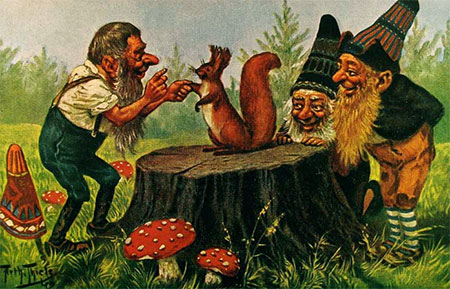
The Secret History of Gnomes.
-By Angelique Duncan
When one sees a statue of a garden gnome one would never realize the grand and noble history that they hold. Their beginnings are much loftier than the life they hold now, residing in the suburbs among the daises and St. Augustine.
The name Gnome quite literally means “Earth Dweller” and is synonymous with Pygmaei or as we know the term today, Pygmies. Once believed to stand 3-4 feet tall, masculine, strong in physique with long beards. Their possible history reaches back to the ancient Roman Greco era to a tribe in Greek mythology who were secondary deities who co existed with humans. The Gnomes were considered highly skilled in nature magic. Gnomes were seen as benevolent beings that were intelligent and wise, hard working in manual labor, peaceful in nature yet fierce defenders when necessary. They were the guardians of farmland; gardens and small livestock and forest animals. When lands were under attack they rode upon goat back brandishing spears to drive out the invaders.
In Roman mythology they were considered akin to the Roman fertility god Priapus protector of livestock fruit and gardens and considered very virile. It is believed that Gnomes are depicted consistently as male figures in history and rarely referenced as female in that the Gnomes were defenders of the meek and all things worthy of protection. It is believed they were very protective of their women and would defend them to all cost against predators and intruders, and later in history from humans.
In Celtic and Germanic lore, the Gnomes were a tribe attributed with Earth element magic and were defenders of mines and under ground tunnels. It was believed that gnomes could move through the Earth and breath underground with the same ease their human counterparts do above ground in the air. Some associate Gnomes as descendants of the Dwarves of Germanic and Norse legends for the ability to move underground and the belief that Gnomes were skilled miners. It was thought that they helped to build under ground tunnels to hide treasures and riches of the fae folk after the great invasions of ancient Ireland, and from humans in modern times.
The history and genealogy of the Gnomes is also believed to be traced to the Tomte or Nisse of Scandinavian folklore. The Tomote are sometimes believed to be an incarnation of a deceased ancestor of the home who comes back to defended the children and animals of the estate and would help with chores, particularly gardening and farm work. The Scandinavian folklore of the Tomote gave rise to the legend of and has associations with the winter elves who appear at Yule.
The size of the Gnomes is widely accepted as a physical attribute, although some historians and mythologist suggest that their representation of small size was more figurative than literal in that in their possible origins they came form lesser spirits or gods. The modern depiction of Gnomes in literature is significantly smaller than what is written in ancient mythology. The modern accepted stature of a Gnome is 2-3 feet tall and in many instances as short as 1 foot tall.
One theory between folklorist and mythologist is that Gnomes adapted to the world around them. That the Gnomes became smaller to better navigate an ever-increasing population of humans and development. Shape shifting to a smaller size helps to keep them hidden. Others believe that the gradual change of Gnomes appearance was the result of the Christian church marginalizing pagan deities through depictions of art and restructuring of legends to aid in making Christianity more palatable to Pagans. Many descriptions of Pagan deities through the Christian church had their attributes downplayed and magical properties lessened. Benevolent entities and magical creatures of Pagan nature religions were often diminished from noble in spirit to mischievous sometimes comical and in most instances considered dangerous as the Church weaned the populace from their previous beliefs to Christianity. By making these entities appear small made them seem less powerful than the Church and what it’s religious deities had to offer. Stories of Gnomes were homogenized more closely with legend of Dwarves and described as irritable, impatient, war like and ugly in appearance. The Gnomes as stoic guardians eventually faded into the stuff of myths.
The use of small statues of Gartenzwege or garden dwarf has remained tremendously popular through out Europe since the 1600’s. Folks would display a small porcelain statue of a Gnome in there home as a protector. Tying to the legends of the Tomte. It was common practice to keep either a wooden, terracotta or ceramic Gnome in ones garden to act as a guardian to discourage nighttime intruders invading ones crops. A popular folk tale in the 1970’s was that Gnome statues secretly came to life after dark working their gardens, shooing away pests. When the sun rose they returned to their post, turning back to stone.
The industry for lawn statues grew in time with demand for garden gnomes becoming hugely popular in pre Word War II Germany. Most were produced from hand sculpted molds, however declined post war to only a few original family manufacturers. They are now mass- produced all over the world using cheaper materials. The depiction has changed as well. Once the imagery was more sober and wise in appearance however after release of Disney’s ‘Snow White and the Seven Dwarves”, Gnome statues took on the more rounded chubby appearance and became seen as more comical nature. Gnomes have had many depictions in literature and often interchangeable to different small statured magical species, affecting their representation in art and statuary.
Till this day Gnomes enjoy popularity in culture. Garden Gnomes have become a central figure in games and pranks known as “gnoming”. One incarnation of “gnoming” is to steal a Gnome from it’s garden and place it randomly in another so that the Gnome travels the neighborhood, often appearing in unconventional places like on rooftops or inside mailboxes. Another popular fad is to send a gnome with a note attached to travel around the world to see how far it will go and if it will return back to it’s previous location. Some Gnomes become victims of theft that results in a ransom note listing bizarre demands.
Perhaps the existence of Gnome like creatures has existed in so many cultures and mythologies due to their ability to travel great distances undetected under ground. Maybe those cheery faced, pointy hat statues decorating the lawns of the sub-burbs still enjoy late night adventures. Is it possible the reason the petunias were spared from the grasshoppers as the result of the fierce protection of ones garden Gnome? Maybe. The only one who knows is the Gnome, and he is stone faced and isn’t speaking.

Angelique Duncan is proprietor of Twilight Faerie Nostalgic and Capricious Objects. Check out her artist page to find links to her shops and vintage inspired traditional holiday art. Visit again next month for more traditions and folklore.